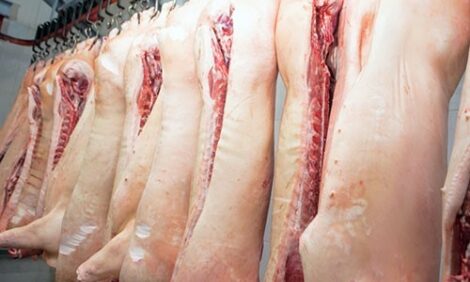



Saskatchewan Producers Adjust to Processing Plant Closure
CANADA - With the closure of Maple Leaf Food's Mitchell's Gourmet Foods pig slaughtering plant in Saskatoon, due for completion at the end of the month, the province's hog producers appear surprisingly well prepared for the change.The decision by Maple Leaf to close the aging primary pork processing plant in Saskatoon was announced last October. The move is part of a major restructuring under which Maple Leaf is either selling or closing many of its processing plants to make way for a second shift at its Brandon facility as it focuses the bulk of its hog kill there.
Displaced Saskatoon Hogs Directed to Brandon, Red Deer, U.S.
“Since the announcement of the closure and the attempt to assign Saskatoon plant animals into Brandon, producers have been searching for alternative opportunities,” says SPI Marketing Group General Manager Don Hrapchak.
“Many of the producers opted to sign with Maple Leaf and deliver their animals to Brandon but many have also opted to find alternative choices. That being the Red Deer plant run by Olymel and, of course, many producers are looking at the United States for an alternative market to Brandon.”
Big Sky Farms Move Bulk of Its Hogs South
Humboldt based Big Sky Farms, one of Canada's largest hog producers, has already made its own arrangements.
CEO Florian Possberg explains, “Big Sky Farms used to send a lot of hogs to Saskatoon, somewhere around 40 loads a week. I think we've shipped two loads to Saskatoon since Easter time so we've kind of phased out of the Saskatoon plant already as they were winding down business.”
Possberg observes, “It appears that most of the producers have made plans and it looks like we'll be able to find markets for our pigs.”
Delays in Double Shifting Plants in Brandon and Red Deer Limit Options
Possberg admits, at this point, the alternatives are limited.
“There really wasn't any increase in slaughter capacity in western Canada so there may be a few extra hogs going west, or there's certainly a number of hogs going to Brandon. A number of producers have found additional markets in the U.S. and it's certainly the case for a lot of our Big Sky hogs. And, as long as we have the U.S. market to act as a safety valve for us, we can do that. There's an appetite for additional hogs to keep plants at full capacity in the U.S. and as long as that's the case we'll find a home for our hogs.”
Hrapchak agrees, “The important part is that there is and will be a home for all the hogs after Saskatoon closes.”
He stresses, “The first thing that producers should recognize and remember, most of the hogs that were destined for the Saskatoon plant are still under contract with Maple Leaf Foods. Those hogs will be directed to the Brandon facility for the remainder of their contracts.”
Continued Reorganization Anticipated
“One of the keys to the success or ongoing success of the Canadian industry is certainly having a vibrant domestic processing sector,” says Fiona Boal, the executive director for food and agribusiness research with Rabobank International.
“There will definitely be some adjustment in packing capacity. We look at what the two big players have announced over the last six months, they've certainly indicated that they plan to rationalize their processing capacity. That will take some time to work through and their success at double shifting the plants they intend to is yet to be seen.”
While Boal expects pork packing plant closures to reduce capacity for a short period of time she remains hopeful that overall the Canadian packing capacity won't actually fall.
Packing Industry Restructuring Expected to Influence Production
Meanwhile Boal expects the restructuring of the Canadian packing industry to result in a slight reduction in sow numbers and continued movement of a lot of live hogs across the border.
“I think immediately we may see some slight downturn in total output in terms of the Canadian industry remembering too that the export of live pigs into the U.S. is not expected to stop and, in fact, may become increasingly important to some producers, particularly those close to the border in the western states. I think we will also see the industry in Quebec and in Ontario probably start to contract and there will be some consolidation in terms of both processing assets and production assets.”
Producers Forced to Adjust
Possberg notes producers have adjusted because they have had to, but he remains concerned.
“Obviously some producers that have less than full semi loads that used to deliver to Saskatoon and could do that within an hour of their home, it's going to be a big inconvenience because they have to go through assemblies. For us to ship our extra hogs to the U.S. there's a tremendous freight bill attached.”
He admits, “Longer term the reality is, unless we have some alternatives, we're probably going to see some producers phase out and we are going to see producers phase out finishing and send smaller pigs to the U.S. just because the freight cost on smaller animals is a lot less.”
Hrapchak believes, “Producers will initially have a difficult time coming to grips with the fact that a meat packing plant that's been in Saskatoon and Saskatchewan for the past 60 odd years will no longer be available to them. It will require a change. It will require some forward planning on ensuring their animals are booked prior to delivery and a little bit more coordination. Especially when you used to ship your animals just 20 miles down the road, shipping them 400 to 500 miles or so requires a little bit more planning.”
Future Remains Promising for Saskatchewan Hog Industry
Possberg concludes, “There are interested parties in Saskatchewan that are working hard at replacing the slaughter capacity that has been lost down the road. We know that there's good intentions to double shift Brandon and Red Deer so we've got to get through this tough spot that we're in here in Saskatchewan. But I think we have reason to believe that the future still holds a lot of promise for our industry here.”








